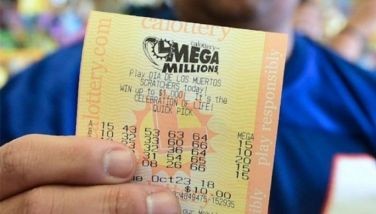Conquering Europa with beaches and bibingka
April 15, 2007 | 12:00am
A round the world in 80 minutes… Well, in a manner of speaking a person could become a globetrotting Phileas Fogg at last month’s Internationale Tourismus-Börse (ITB-Berlin) travel fair held in Berlin, Germany.
You see, the ITB is like the Olympics or the Super Bowl of the tourism and travel industry. It features more than 10,000 exhibitors from 180 countries and regions, representing all levels of the tourism trade such as tour operators, booking systems, travel destinations, airlines, hotel and transport services all ensconced in Messe Berlin’s 150,000-square-meter exhibition space with nearly 170,000 overall visitors. Now, that is near the total number of concertgoers at Roger Waters’ performance of Pink Floyd’s "The Wall" at the Berlin Wall. (Or David Hasselhoff’s fans in Germany.)
The ITB, though, is all about tearing down metaphorical walls and crossing borders to get a taste of the good life.
Thus, each pavilion tried to outdo the other in terms of what they could offer prospective travelers. Would you believe the Egyptians put up a replica of the Sphinx, which visitors half-expected to start spewing riddles? "What walks on all fours in daytime…" In the Kazakhstan pavilion there were beautiful hand-woven items for sale  from fur hats to camel dolls to tasseled bags. Disappointingly, Borat didn’t show up. At the Qatar Airways booth, Lady Liberty was there. Well, at least a woman in a Statue of Liberty costume  on stilts. At the center of the Scandinavian hall, a statuesque blonde model was being body-painted by a landscape artist. Male travelers were tempted to cut short their ITB tour just to sit and watch the whole proceedings  for art’s sake, of course. The artistically inclined were tempted to get a brush, dab it in acrylic and start painting mountains. (Paint mountains, not paint on mountains.) Just like Picasso whose posters for his retrospective adorned the Düsseldorf booth. The huge "Incredible India" pavilion offered demonstrations of Ayurveda by astrologers and artisans, application of henna tattoos, and distribution of bindis and bangles. There was a fiesta atmosphere at the South American and African halls also. Somewhere, a marching band was playing the Beach Boys’ Barbara Ann. (How could other booths compete with nude girls and the Beach Boys, anyway?)
But for some reason, the Philippine booth, headed by the Department of Tourism (DOT) with the participation of major travel agencies and tour operators, drew a record number of foreigners, even if our neighbors in the Asian hall (Malaysia, Korea, Thailand, Cambodia, Japan, etc.) flaunted bigger budgets, more monolithic structures, and all sorts of gimmickry. But we had an ace up our sleeves. Two words: rice cakes. Not just that. Team Philippines also had three things going for it: creativity and resourcefulness (which are typical Pinoy traits), as well as the reputation of our country as one of the top dive destinations in the world.
"I would proudly say that the Philippines is now no. 4 behind the more popular Egypt with its Red Sea, the Maldives and the Caribbean. But our country is gaining ground," enthused Venus Tan, Philippine DOT director of Western, Central and Eastern Europe.
Tan, who heads the DOT’s Frankfurt office, talked about the Boat Show (Boot Messe) in Düsseldorf last January, which is the biggest dive fair in Europe. A couple of years back, she found out that there were Dutch, Italian and German nationals who operate dive centers and resorts in the Philippines scattered all over the venue, selling our country as a top dive destination on their own. What the DOT did in 2006 was to put all of them in one booth, and that has made a huge difference.
"These Europeans have adopted the Philippines as their home, and they want to promote diving for us," Tan said. "We Filipinos need to do something for the dive industry. That’s where our strength lies. Our competitors in the travel industry such as Thailand, Malaysia and Indonesia also have beaches, culture and cuisine. But they can’t take diving away from us. We have 7,107 islands, and we have the highest biodiversity in the world."
The DOT team met with a member of the German Bundestag who’s also a member of the committee on tourism. The Member of Parliament wanted to talk to the DOT representatives headed by Undersecretary Oscar Palabyab about how the Bundestag can support the DOT’s tourism efforts.
Undersecretary Palabyab said, "The consciousness about the Philippines is growing because of our consistent and expanding participation in travel fairs such as the ITB. The Europeans have heard good things about our dive spots. I think we should concentrate more on that area."
Palabyab was in meetings the whole of Day 2 of the ITB travel fair. He was also interviewed by European journalists (from print and broadcast media outlets in Germany, Austria and other countries from the EU), and gamely posed for photos beside the sorbetes cart, ringing the bell. Dig it: he’s probably the world’s most industrious sorbetero, promoting the Philippines with its 7,000 flavors and then some.
"(The foreign journalists) asked what are the things our country has to offer to tourists, how many hours to get to Manila from Europe, and how will the DOT expand its capacity in accommodating tourists. No negative impressions na about our country." That wasn’t the case a couple of years back with the Sidapan kidnappings looming like a specter in the European consciousness.
The only concern of reporters nowadays is about the lack of direct flights from Germany to Manila. Good question. The Undersecretary’s answer was as good: create the traffic, and they will fly. But there is a need to attract new investors, he underscored. "We need to address the other side of the equation, and that is infrastructure. Aside from sales missions such as this, we need to have investment-promotion missions as well."
A step in the right direction is President Gloria Macapagal-Arroyo’s Super Regions project, where Central Philippines (which includes Southern Tagalog, Northern Visayas, and parts of Palawan) is being groomed as a tourism hub. Thus, the thrust is to develop infrastructure centered on tourism, for all government offices to support tourism initiatives, and for senators and congressmen from these specific regions to think tourism in their agenda. Secretary Joseph "Ace" Durano has already made the proposal to diversify by looking into areas such as Romblon, Leyte, Legaspi and Dumaguete.
Essential is the support of the private sector in all this. DOT Team Europe tourism, planning and promotions head Verna Buensuceso said, "Secretary Durano always emphasizes ‘joint promotions.’ We want to expand our resources by doing things jointly with our private sector partners."
Palabyab agreed. He said, "It’s a good thing there are companies like Microtel that are taking risks, putting up hotels in Cavite, Nueva Ecija and Tarlac. Imagine that."
Tan said hopefully that promotions and infrastructure developments would go hand in hand. "What we need now is the capacity. The DOT is encouraging investments, and we’re quite happy with new developments such as Microtel, Shangri-La in Boracay, and other projects. The culture of tourism should seep into the grassroots as well. Attracting tourists shouldn’t just be the role of the DOT. It should be everybody’s concern."
For Germany, the DOT has adopted the catchphrase "xxs bis XXL," meaning that the Philippines has the smallest and the biggest to offer in terms of marine life. And the catchphrase is, uh, catching on. Now the Europeans know that our country boasts all types of attractions in the diving world  from the pygmy seahorse, the smallest fish in the world, to the huge whale sharks found in Donsol.
Speaking of attractions, the Philippine booth in this year’s ITB had a drawing power all its own.
The walls were festooned with photos of the country’s rich marine life, beaches (Bora! Bora! Bora!) and the Banawe Rice Terraces, which, according to DOT Frankfurt office sales and PR manager Arnold Gonzales, "is the only Wonder of the World that was built for the living and not for the dead." There was a wellness counter and massage area where Jomar Flores of Sanctuario and Heidi Abante of Mandala Spa provided free backrubs and hilot to visitors. The waiting list for the free spa services was so long that the people at the end of the line had no choice but to attend next year’s ITB travel fair to try the indigenous Filipino healing method (or, better yet, fly to Manila or Boracay for the whole shebang).
"We are attending a meeting here in Berlin to push our medical wellness packages," enthused Buensuceso. "There is a move in Europe to come up with an international network for all the resorts, hotels and hospitals that offer medical wellness, and they are inviting the Philippines to be one of the pioneers, along with Cyprus and Iceland."
Our country is becoming famous for its holistic wellness packages because, she explained, "we concentrate not only on getting patients well again, but also on making them feel even better."
At the Philippine booth, there was also an authentic sorbetes cart with delicious coconut and mango ice cream dispensed by a DOT rep. The poor guy wasn’t able to take a breather because of the swarm of foreigners wanting a taste of dirty ice cream (we Pinoys love to point that we even use it as palaman sa monay). Some came back for seconds and thirds. Those who were contemplating on coming back for fourths but decided not to drifted instead to the kitchen where amiable cooks Helen Schaefler, Evelyn Baldueza and DOT Team Europe coordinator Mirla Valera were cooking up a fresh, fragrant batch of kalamay and bibingka. One of the many visitors asked if they had dinuguan also. Maybe next year there will be sisig also to go with the ice-cold San Miguel beer served during happy hour at the booth. (The Germans I spoke to liked our delicious local brew; to think that these people invented Oktoberfest.)
The DOT has also launched a new brochure playing up the fact that, yes, we have diving in the Philippines but there are "plus" factors as well. "Plus" could mean cuisine, culture, adventure and, of course, friendly and hospitable people. The Europeans go to the Philippines for diving, but once they come out of the water they can indulge in other activities such as playing golf, trekking, biking, rappelling and spelunking, or even going to spas and wellness centers. Once the foreigners are in, the resorts can always diversify and enhance their packages. Tan said that when Europeans visit the Philippines and see our beaches and dive spots, they get the urge to stay for good.
"There is one European who was bound for Hong Kong with a stopover in Manila. He failed to make the connecting flight, so he had to wait. He has stayed na for 15 years. Never left (laughs). Now he runs a dive center and resort with his partner."
If Phileas Fogg strayed into the Philippines, he would’ve ended up staying and swimming with whale sharks in Donsol.
For comments, suggestions, curses and invocations, e-mail iganja_ys@yahoo.com.
You see, the ITB is like the Olympics or the Super Bowl of the tourism and travel industry. It features more than 10,000 exhibitors from 180 countries and regions, representing all levels of the tourism trade such as tour operators, booking systems, travel destinations, airlines, hotel and transport services all ensconced in Messe Berlin’s 150,000-square-meter exhibition space with nearly 170,000 overall visitors. Now, that is near the total number of concertgoers at Roger Waters’ performance of Pink Floyd’s "The Wall" at the Berlin Wall. (Or David Hasselhoff’s fans in Germany.)
The ITB, though, is all about tearing down metaphorical walls and crossing borders to get a taste of the good life.
Thus, each pavilion tried to outdo the other in terms of what they could offer prospective travelers. Would you believe the Egyptians put up a replica of the Sphinx, which visitors half-expected to start spewing riddles? "What walks on all fours in daytime…" In the Kazakhstan pavilion there were beautiful hand-woven items for sale  from fur hats to camel dolls to tasseled bags. Disappointingly, Borat didn’t show up. At the Qatar Airways booth, Lady Liberty was there. Well, at least a woman in a Statue of Liberty costume  on stilts. At the center of the Scandinavian hall, a statuesque blonde model was being body-painted by a landscape artist. Male travelers were tempted to cut short their ITB tour just to sit and watch the whole proceedings  for art’s sake, of course. The artistically inclined were tempted to get a brush, dab it in acrylic and start painting mountains. (Paint mountains, not paint on mountains.) Just like Picasso whose posters for his retrospective adorned the Düsseldorf booth. The huge "Incredible India" pavilion offered demonstrations of Ayurveda by astrologers and artisans, application of henna tattoos, and distribution of bindis and bangles. There was a fiesta atmosphere at the South American and African halls also. Somewhere, a marching band was playing the Beach Boys’ Barbara Ann. (How could other booths compete with nude girls and the Beach Boys, anyway?)
But for some reason, the Philippine booth, headed by the Department of Tourism (DOT) with the participation of major travel agencies and tour operators, drew a record number of foreigners, even if our neighbors in the Asian hall (Malaysia, Korea, Thailand, Cambodia, Japan, etc.) flaunted bigger budgets, more monolithic structures, and all sorts of gimmickry. But we had an ace up our sleeves. Two words: rice cakes. Not just that. Team Philippines also had three things going for it: creativity and resourcefulness (which are typical Pinoy traits), as well as the reputation of our country as one of the top dive destinations in the world.
"I would proudly say that the Philippines is now no. 4 behind the more popular Egypt with its Red Sea, the Maldives and the Caribbean. But our country is gaining ground," enthused Venus Tan, Philippine DOT director of Western, Central and Eastern Europe.
Tan, who heads the DOT’s Frankfurt office, talked about the Boat Show (Boot Messe) in Düsseldorf last January, which is the biggest dive fair in Europe. A couple of years back, she found out that there were Dutch, Italian and German nationals who operate dive centers and resorts in the Philippines scattered all over the venue, selling our country as a top dive destination on their own. What the DOT did in 2006 was to put all of them in one booth, and that has made a huge difference.
"These Europeans have adopted the Philippines as their home, and they want to promote diving for us," Tan said. "We Filipinos need to do something for the dive industry. That’s where our strength lies. Our competitors in the travel industry such as Thailand, Malaysia and Indonesia also have beaches, culture and cuisine. But they can’t take diving away from us. We have 7,107 islands, and we have the highest biodiversity in the world."
The DOT team met with a member of the German Bundestag who’s also a member of the committee on tourism. The Member of Parliament wanted to talk to the DOT representatives headed by Undersecretary Oscar Palabyab about how the Bundestag can support the DOT’s tourism efforts.
Undersecretary Palabyab said, "The consciousness about the Philippines is growing because of our consistent and expanding participation in travel fairs such as the ITB. The Europeans have heard good things about our dive spots. I think we should concentrate more on that area."
Palabyab was in meetings the whole of Day 2 of the ITB travel fair. He was also interviewed by European journalists (from print and broadcast media outlets in Germany, Austria and other countries from the EU), and gamely posed for photos beside the sorbetes cart, ringing the bell. Dig it: he’s probably the world’s most industrious sorbetero, promoting the Philippines with its 7,000 flavors and then some.
"(The foreign journalists) asked what are the things our country has to offer to tourists, how many hours to get to Manila from Europe, and how will the DOT expand its capacity in accommodating tourists. No negative impressions na about our country." That wasn’t the case a couple of years back with the Sidapan kidnappings looming like a specter in the European consciousness.
The only concern of reporters nowadays is about the lack of direct flights from Germany to Manila. Good question. The Undersecretary’s answer was as good: create the traffic, and they will fly. But there is a need to attract new investors, he underscored. "We need to address the other side of the equation, and that is infrastructure. Aside from sales missions such as this, we need to have investment-promotion missions as well."
A step in the right direction is President Gloria Macapagal-Arroyo’s Super Regions project, where Central Philippines (which includes Southern Tagalog, Northern Visayas, and parts of Palawan) is being groomed as a tourism hub. Thus, the thrust is to develop infrastructure centered on tourism, for all government offices to support tourism initiatives, and for senators and congressmen from these specific regions to think tourism in their agenda. Secretary Joseph "Ace" Durano has already made the proposal to diversify by looking into areas such as Romblon, Leyte, Legaspi and Dumaguete.
Essential is the support of the private sector in all this. DOT Team Europe tourism, planning and promotions head Verna Buensuceso said, "Secretary Durano always emphasizes ‘joint promotions.’ We want to expand our resources by doing things jointly with our private sector partners."
Palabyab agreed. He said, "It’s a good thing there are companies like Microtel that are taking risks, putting up hotels in Cavite, Nueva Ecija and Tarlac. Imagine that."
Tan said hopefully that promotions and infrastructure developments would go hand in hand. "What we need now is the capacity. The DOT is encouraging investments, and we’re quite happy with new developments such as Microtel, Shangri-La in Boracay, and other projects. The culture of tourism should seep into the grassroots as well. Attracting tourists shouldn’t just be the role of the DOT. It should be everybody’s concern."
For Germany, the DOT has adopted the catchphrase "xxs bis XXL," meaning that the Philippines has the smallest and the biggest to offer in terms of marine life. And the catchphrase is, uh, catching on. Now the Europeans know that our country boasts all types of attractions in the diving world  from the pygmy seahorse, the smallest fish in the world, to the huge whale sharks found in Donsol.
Speaking of attractions, the Philippine booth in this year’s ITB had a drawing power all its own.
The walls were festooned with photos of the country’s rich marine life, beaches (Bora! Bora! Bora!) and the Banawe Rice Terraces, which, according to DOT Frankfurt office sales and PR manager Arnold Gonzales, "is the only Wonder of the World that was built for the living and not for the dead." There was a wellness counter and massage area where Jomar Flores of Sanctuario and Heidi Abante of Mandala Spa provided free backrubs and hilot to visitors. The waiting list for the free spa services was so long that the people at the end of the line had no choice but to attend next year’s ITB travel fair to try the indigenous Filipino healing method (or, better yet, fly to Manila or Boracay for the whole shebang).
"We are attending a meeting here in Berlin to push our medical wellness packages," enthused Buensuceso. "There is a move in Europe to come up with an international network for all the resorts, hotels and hospitals that offer medical wellness, and they are inviting the Philippines to be one of the pioneers, along with Cyprus and Iceland."
Our country is becoming famous for its holistic wellness packages because, she explained, "we concentrate not only on getting patients well again, but also on making them feel even better."
At the Philippine booth, there was also an authentic sorbetes cart with delicious coconut and mango ice cream dispensed by a DOT rep. The poor guy wasn’t able to take a breather because of the swarm of foreigners wanting a taste of dirty ice cream (we Pinoys love to point that we even use it as palaman sa monay). Some came back for seconds and thirds. Those who were contemplating on coming back for fourths but decided not to drifted instead to the kitchen where amiable cooks Helen Schaefler, Evelyn Baldueza and DOT Team Europe coordinator Mirla Valera were cooking up a fresh, fragrant batch of kalamay and bibingka. One of the many visitors asked if they had dinuguan also. Maybe next year there will be sisig also to go with the ice-cold San Miguel beer served during happy hour at the booth. (The Germans I spoke to liked our delicious local brew; to think that these people invented Oktoberfest.)
The DOT has also launched a new brochure playing up the fact that, yes, we have diving in the Philippines but there are "plus" factors as well. "Plus" could mean cuisine, culture, adventure and, of course, friendly and hospitable people. The Europeans go to the Philippines for diving, but once they come out of the water they can indulge in other activities such as playing golf, trekking, biking, rappelling and spelunking, or even going to spas and wellness centers. Once the foreigners are in, the resorts can always diversify and enhance their packages. Tan said that when Europeans visit the Philippines and see our beaches and dive spots, they get the urge to stay for good.
"There is one European who was bound for Hong Kong with a stopover in Manila. He failed to make the connecting flight, so he had to wait. He has stayed na for 15 years. Never left (laughs). Now he runs a dive center and resort with his partner."
If Phileas Fogg strayed into the Philippines, he would’ve ended up staying and swimming with whale sharks in Donsol.
BrandSpace Articles
<
>















